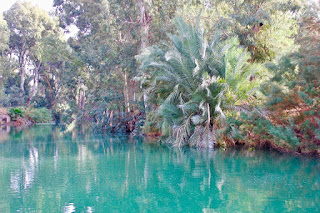The Baptism of Christ.
Today is the feast of the Baptism of Our Lord. After the Incarnation and the Epiphany, and before Candlemas, the Presentation of Christ to the Temple, this is the major milestone in the Gospel narrative of the life of Jesus, but spiritually speaking it is much more, regarding our economy of salvation, it is the way God gave mankind to be partakers of his body, the mean of his grace, the way to be part of the assembly of the faithful known as the Church. The event is mentioned clearly in the four gospels, not only that, but even secular historians regard the Baptism and the Crucifixion as the starting point for the study of the historical Jesus. In the accounts of Matthew, Luke, Mark, a voice thunders from heaven You are my beloved Son, in whom I am well pleased. In Matthew, John the Baptist says I have need to be baptised of thee, and comest thou to me? But Jesus convinces him to baptise him. In Luke, the heavens open and the Holy Spirit descend on Christ, this is stressed even more in John, in which the other disciples are baptised. A location of the site of the Baptism is given, in Bethabara, beyond Jordan. Today thought to be on the eastern bank of the river Jordan, near Jericho. During my latest trip to Israel, in November, I was blessed to make the sign of the cross with those waters Go ye therefore, and teach all nations, baptizing them in the name of the Father, and of the Son, and of the Holy Ghost. Originally in the early Church, Baptism was celebrated on the same day of Christmas and the Epiphany, whereas it is now the tradition of the Church to celebrate it on the Sunday following the Epiphany, when the Epiphany occurs on a Sunday, it might be celebrated on the following Monday. In the Baptism of Christ the Trinity appears in its full glory; God thundering from the heavens, the Spirit descending on Christ, the light of the nations - the sacrament through which our sin is washed away with the waters of the Jordan and through which he made us partakers of his body and blood, through which we became whole in him and we in him. Saint Irenaeus said He [Jesus] came to save all through himself; all, I say, who through him are reborn in God: infants, and children, and youths, and old men.
In Christian art, the Baptism of the Lord, has its own iconography, developed as early as the 4th century with the moving example from the catacombs of San Callisto in Rome. Christ, standing, is being baptised with water from the river Jordan, the Baptist pours it gently on his head. The scene developed substantially in Medieval art, and by the 15th century, there is a full iconography with the whole Trinity. God the Father, usually shown as a pair of hands, seems to launch the dove of the Spirit spreading its wings over, Christ, gently immersed in the clear waters and ready to spread that message to the whole earth, angels appear singing, playing instruments and giving praise to the first step of Christ's revelation towards Calvary. The Renaissance was a prolific time for this theme, perhaps the most notable examples, and my favourites too, are that of Piero della Francesca and Verrocchio/ Leonardo. The first, set in a bucolic scenery of Gothic echoes has in fact a very precise geometrical scheme, based on symmetry, Piero della Francesca's colours are extremely and yet gently cool. Although the Baptist is just pouring water on Christ's head, the scene gives a sense of great calm, above them appears the Spirit, ready to validate the action in the name of the Father, instead of him though is a tree, diving the scene from top to bottom, in the background are a multitude of people being baptised in eastern Renaissance clothing, an Italian looking Jerusalem is in the background. Three beautiful angels distantly but reverently take part in the scene, they invite the spectator to take part in it. The second work, begun by Andrea di Verrocchio, one of the great masters of Renaissance in Florence, was finished by Leonardo da Vinci nonetheless. Iconographically, the work is very similar, the Baptist, this time standing taller than Christ, pours water on his head with a tiny shell, the hands of the Father seem to free the dove of the Spirit above, ready to bless the unfolding event below with its golden rays of grace. Two much more youthful angels seem to discuss the scene, and we are almost drawn to try and hear what they are saying! This work departs considerably from Piero's sense of symmetry, here the two masters show Florentine extravaganza at its best; the Baptist and Christ seem to be bouncing in that very Quattrocento pose, almost as if their weight is entirely held by those elegantly curved legs - Christ's feet just appear under the water in an incredible illusion, the fruit of great talent. In the background is a splendid Florentine scenery, with hills, lakes, and even in this case with echoes of the Gothic world. Renaissance masters reinvented classical aesthetics and made Christian art and its heavenly message anew through it. Christ speaks to us, come and be baptised in my name. Happy Feast.




Comments
Post a Comment